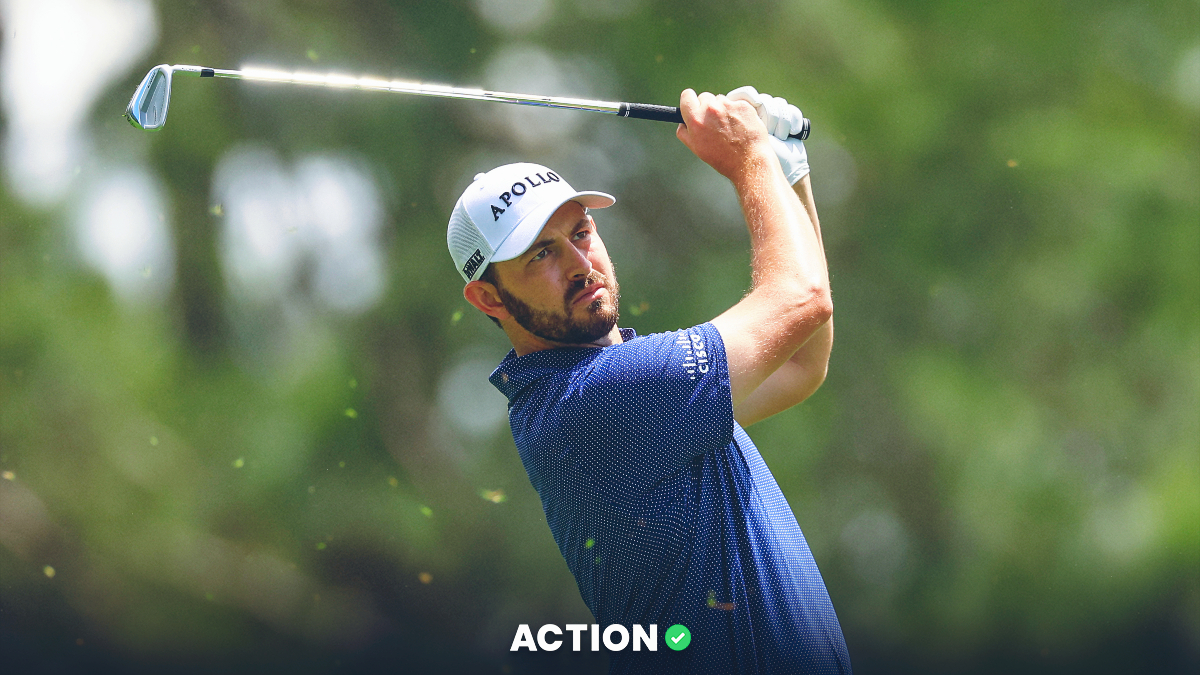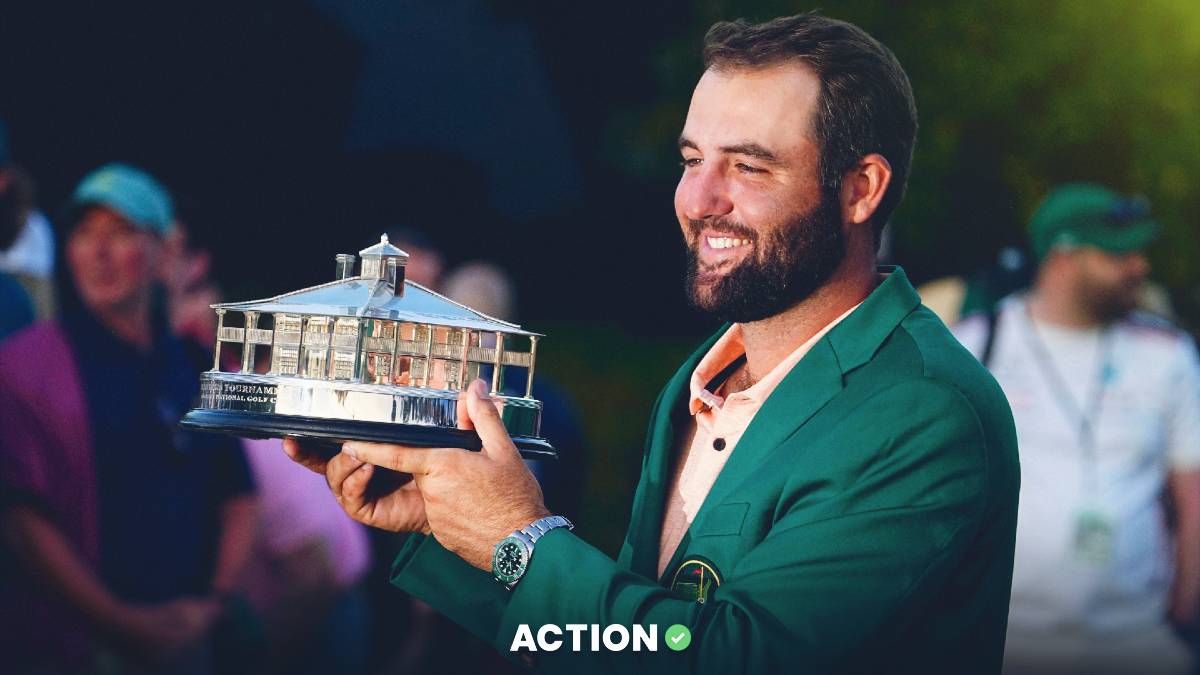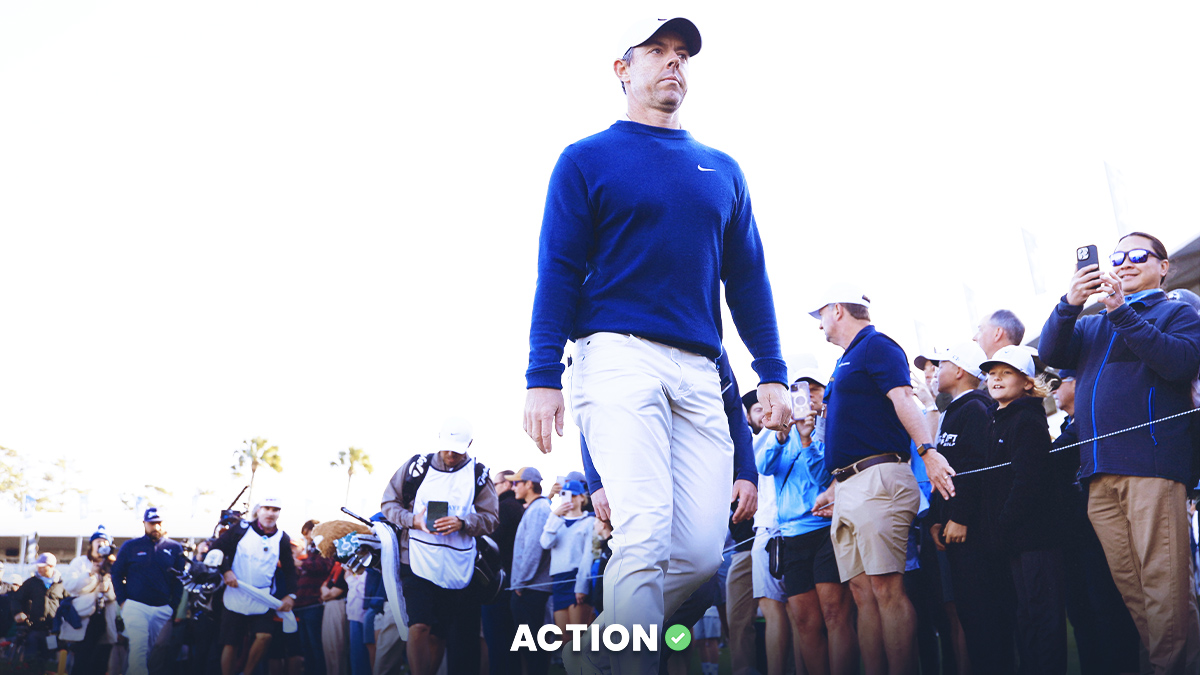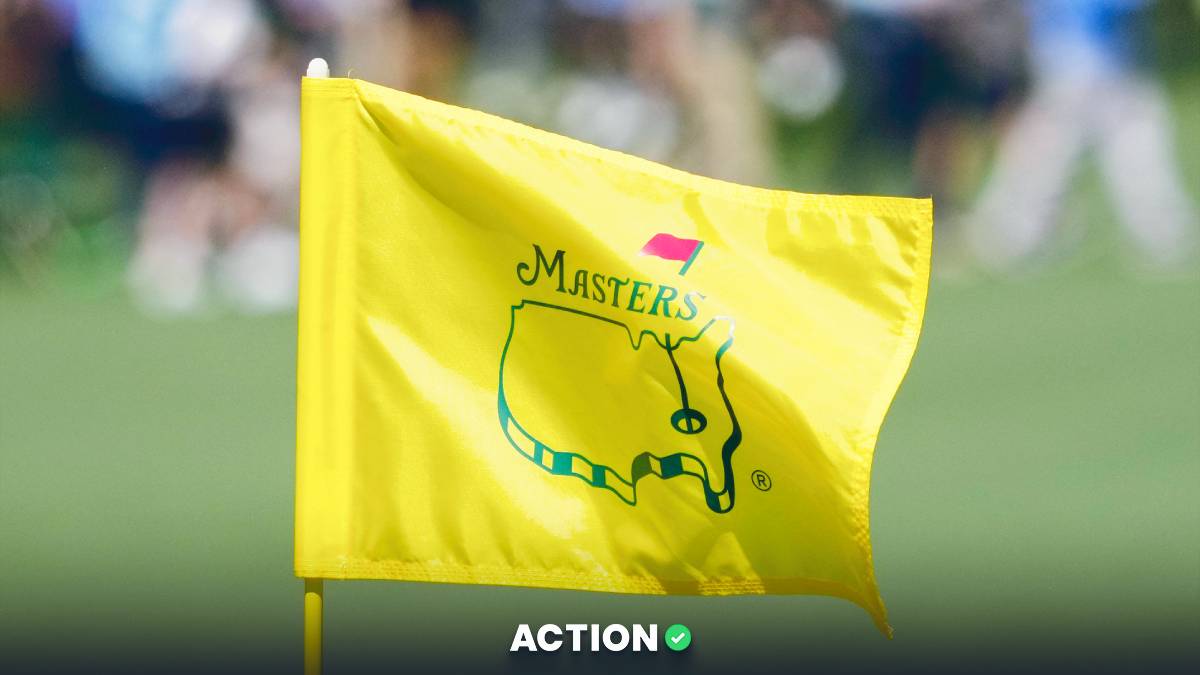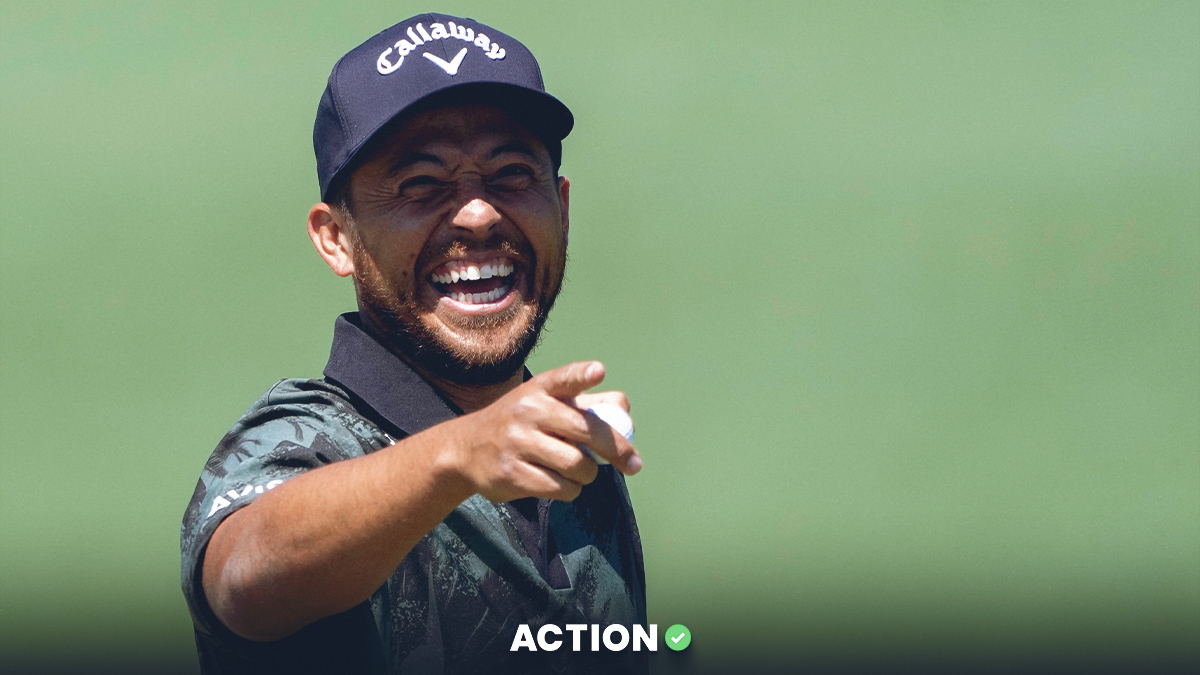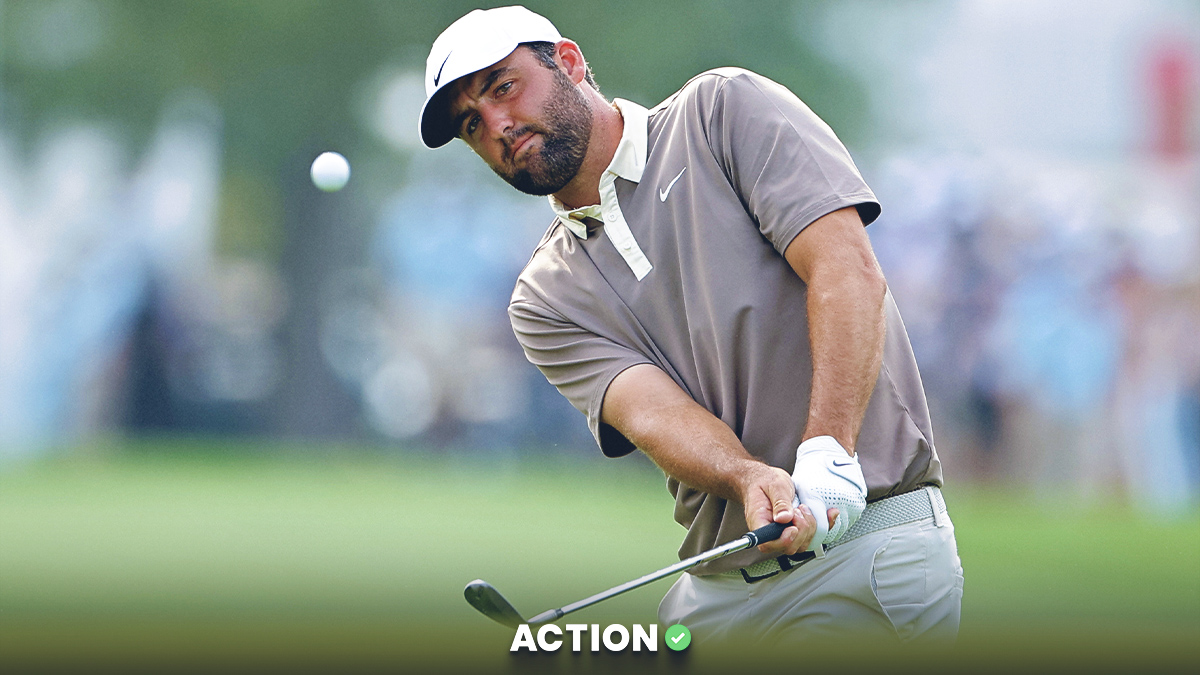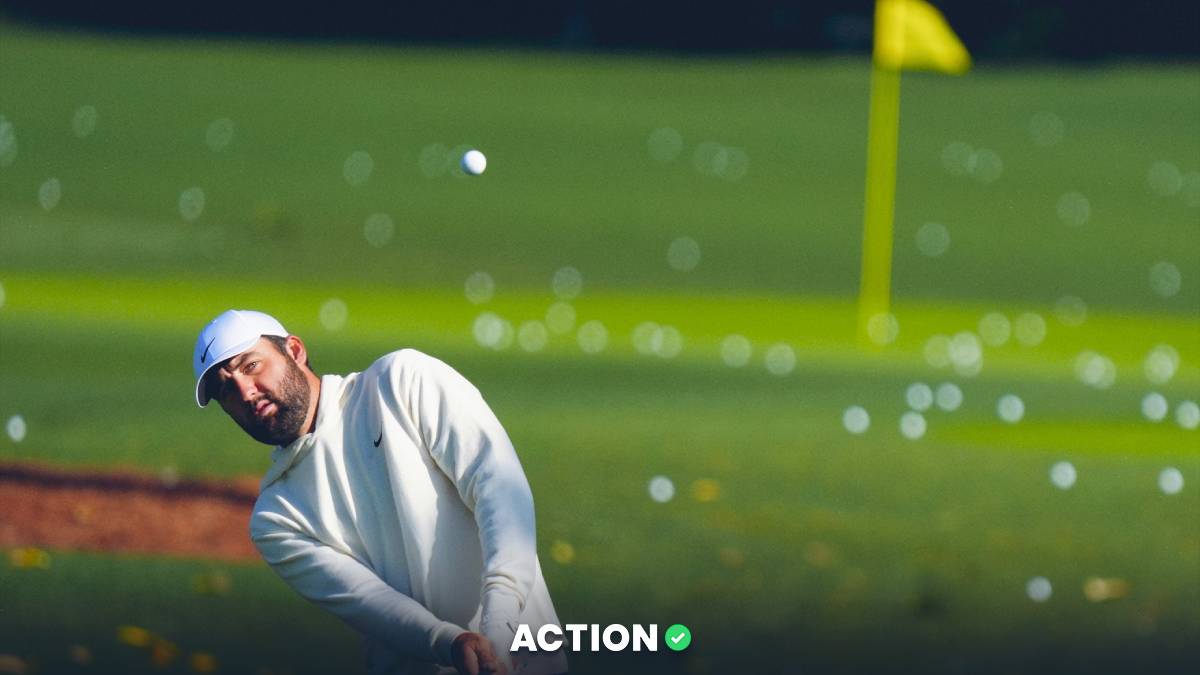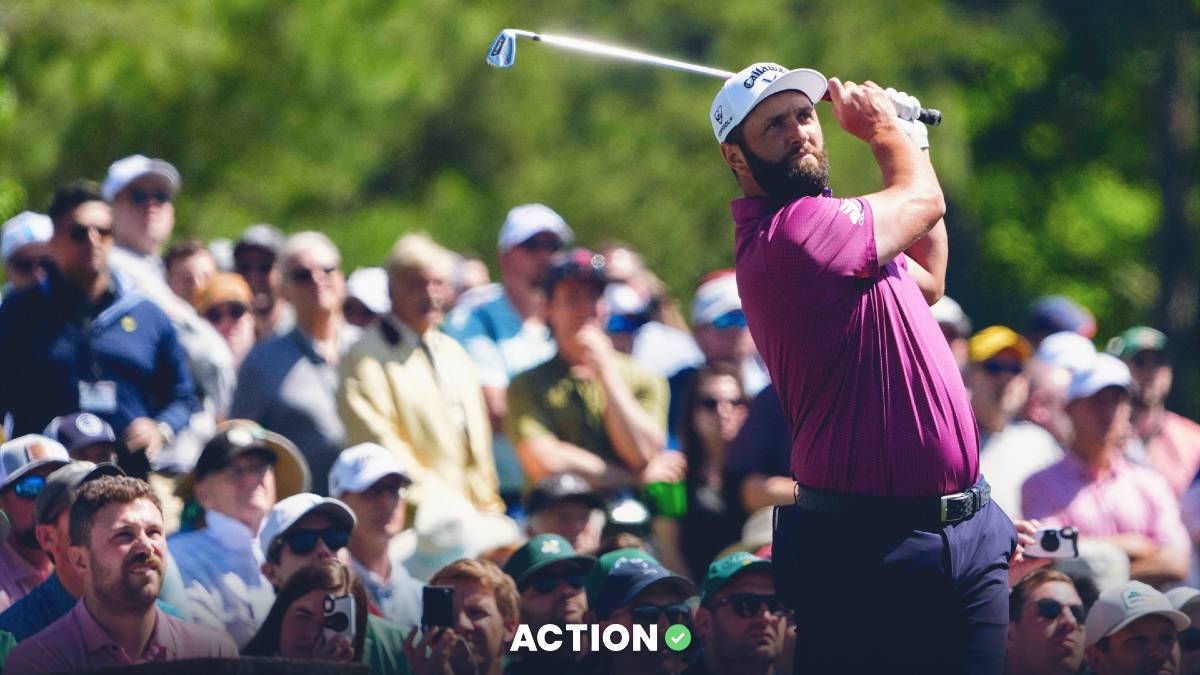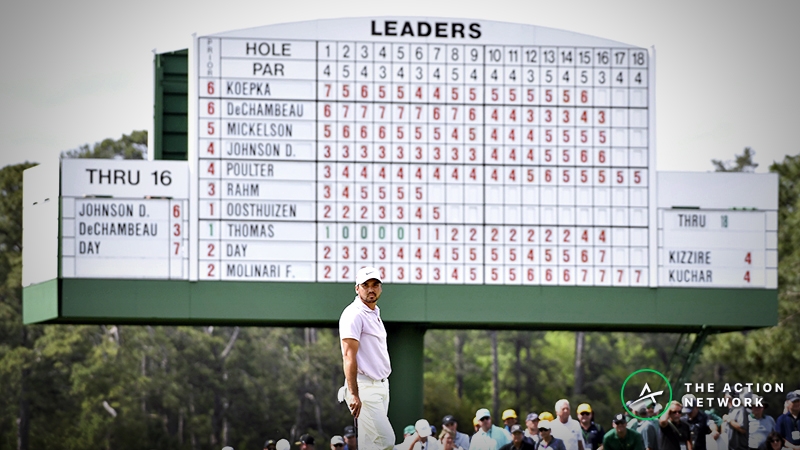Do you want to win your Masters pool? Win. Not just "do well" or come in 20th. Actually win. Then you have to be comfortable with the idea that sometimes you might finish dead last. But fortunately, last pays the same as 20th — nothing.
Our typical recommendation for mass-entry pools like this — in which everyone can use the same teams/players — involves ignoring the most popular selections and trying to find comparable players who will be far less selected, creating leverage over the field.
If the popular selections hit, you're toast. But if they don't, you actually have a chance to win.
We write about this strategy NHL playoff pools, NCAA Tournament brackets, NFL survivor pools and more. Sean Koerner's contrarian March Madness bracket just cashed Florida in the national title game.
There are many ways to set up a Masters pool, but a typical pool involves "Tiers" in which you pick one golfer from each tier, and their total scores will be added up to create your team's overall score. If you're doing a snake draft, a lot of this advice won't apply.
In most tiers pools, you pick around 8ish players, and the top 6ish scores will be counted while the other two are thrown out. The tiers approach prevents everyone from taking the same top six star golfers and instead forces you to go further down the board with your selections.
We'll use EasyOfficePools' standard tiers that use betting odds to sort the tiers, picking one player from the top five tiers and three players from the "everyone else" tier. Let's assume there are 100 people in the pool, and the top four finishers get paid.
Tier 1 will look something like this:
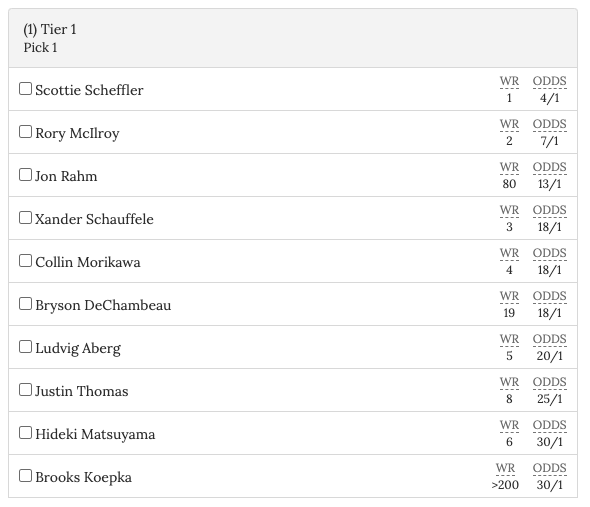
Alright, to the tips and strategy.
1. Don't Try to 'Do Well.' Try to Win.
To win these pools, you need to win. Finishing 20th of 100 pays the same at 99th — you get nothing.
So, you need to differentiate your lineup if you want to win. And you need to get comfortable with the idea that some years, you may come in dead-last by fading the "can't miss" players everyone wants to use.
This concept will inform the rest of my strategy. I don't mind finishing last two years in a row if I can have a chance to win the third year. That pays much more than three straight 40th-place finishes.
Big pools are hard to win, but when it breaks right, differentiating your lineup can pay off. The bigger the pool, the more creative you need to get. Think about the NCAA Tournament this year — all you had to do is stay chalky but pivot off Duke to Houston to give yourself a real chance to take down your bracket.
Don't just take bad players or the worst player in each tier — take comparable players who will be far-less used.
You just need to create unique lineups with leverage. If you do take Scottie Scheffler, make sure the rest of your picks are unpopular so you can create a unique lineup. If you fade Scheffler, you can pick more popular players in other tiers.
2. Just Pick Good Golfers
A few years ago at FantasyLabs, we analyzed millions of DFS lineups and found that floor is much more important than ceiling in golf DFS, because the only thing that correlates with DFS success is making the cut. If you stay in the tournament, you raise your ceiling.
The abundance of modern sports statistics will lead many of your pool participants to overanalyze a big event like the Masters. Who has the most upside? Who has win equity? Who putts the best on Bermuda? Who are the best iron players from 120-140 yards out?
Golf is an inherently random game in a given round or week. Don't take putting, the most random part, and narrow the sample to just a certain type of grass. Just take the good players who hit the ball far and put it close to the hole. In the long run, those players will win out.
The takeaway from that article that stuck with me most: "Just try to make as many 6/6 lineups as you can and hope that at least one of them has everyone score high."
You don't have to pick players in Tiers 5 and 6 who you think will win the tournament; they're in those tiers because they won't win. So, take good players who you think will play well; don't worry so much about "winning upside."
Anyway, I like to use DataGolf's rankings as a measure of ability. Here are a few guys who rank higher in their global rankings than you might expect who you should consider using:
6. Russell Henley
7. Shane Lowry
11. Joaquin Niemann
13. Corey Conners
19. Sergio Garcia
20. Denny McCarthy
28. Michael Kim
37. J.T. Poston
3. Get Contrarian & Find Leverage
Alright, here's where we get creative. You need to figure out who everyone will pick and avoid those players.
Leverage is the idea that you can create value by choosing lower-owned players who have a comparable chance to play well as a similar, higher-owned player. If 50% of the pool uses Scheffler and he does well, 50% of your pool will move up in the standings when he does well. But if you're the only person who uses Taylor Pendrith and he finishes fourth, you're moving up the standings alone if he plays well.
With 100 people in your pool, would you rather be:
- One of 30 people with Brooks Koepka (2.8% chance to win)
- One of five people who used Patrick Cantlay (2.5% chance to win)
To me, the answer is clear. The chances of them winning aren't that different, but what you're gaining on the field if Cantlay does well is massive.
Here are the top players in our FantasyLabs DFS models in leverage score, which compares projected ownership to upside. It's DFS, so it's a bit different, but I think it gives you a decent idea of the guys that no one wants to use, and players who will be popular this week.
It's mostly players who are:
- Boring (Wyndham Clark, Russell Henley)
- LIV players who haven't played well at Augusta (Joaquin Niemann, Bryson DeChambeau)
- Players in poor form or injured (Xander Schauffele)
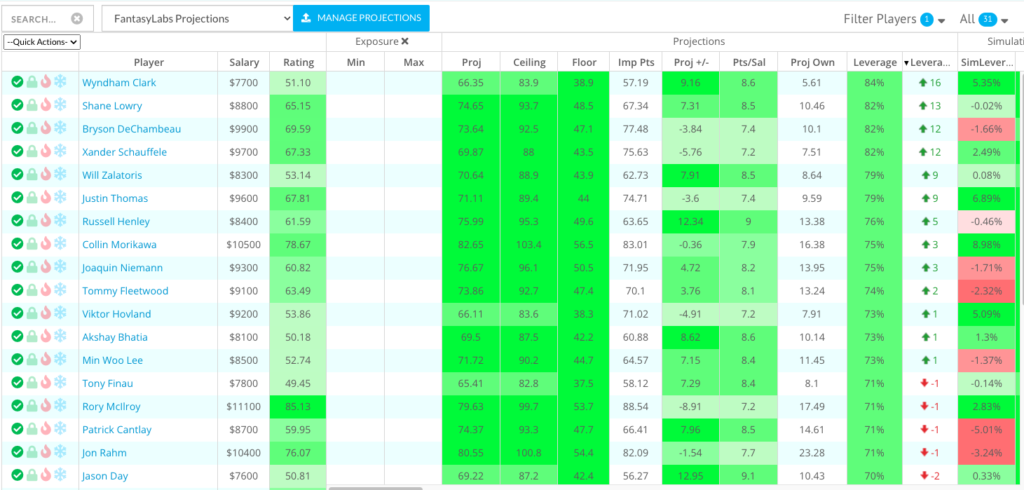
And here are the players with the highest ownership projections. It's mostly players with great course history (Scottie Scheffler, Cam Smith, Corey Conners, Jordan Spieth), and some players in form like Sepp Straka and Robert MacIntyre.
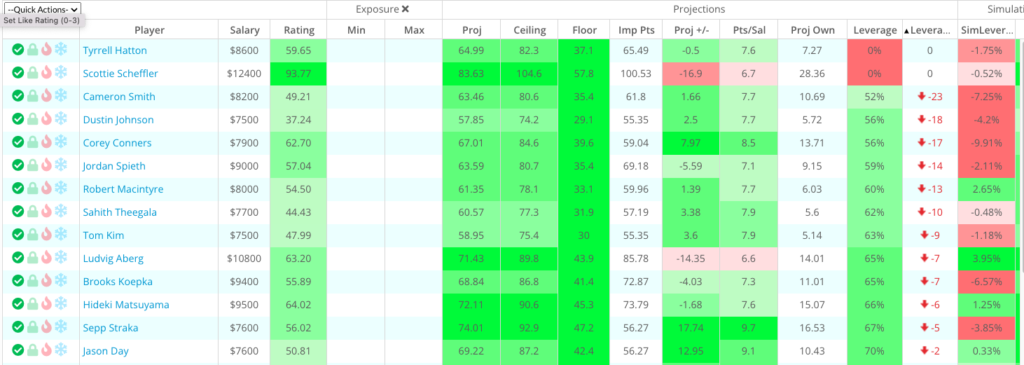
3b. Why Leverage is So Important
When you use the same player as everyone else, it doesn't really help you because the other entries also move up in the standings when that player does well.
Remember, you're just trying to beat the other entries; it doesn't really matter what the numeric scores are.
This visual represents leaderboard movement when Jon Rahm, owned by just two of the top 10 entries, birdies a hole, versus when Scheffler does.
If you've ever been in contention in a tiers golf pool like this, you know the changes in standings slow to a crawl on Sunday when some of your players complete their rounds and your top guys are also used by the entries you're battling for first.
If you're in third with Jon Rahm, but the two entries in front of you also picked him, Rahm playing well doesn't really help you. You need someone else your opponents don't have so you can move up while their position remains the same.
The hard part is you don't know who will be the most-owned golfers in these pools. It's not like the NCAA Tournament, where Yahoo! and ESPN will actually tell you.
So we have to make some assumptions. We do DFS ownership projections at FantasyLabs, which can give you some idea. Tyler Tamboline on X does a good thread highlighting the most recommended players in the industry you'll probably want to avoid.
4. Use Odds, But Not Blindly
Many people will gravitate toward the players in each tier who have the best odds to win.
Most people don't follow golf closely enough to separate top 15 players like Tyrrell Hatton from Russell Henley, let alone Nicolai Hojgaard and Stephan Jaegar, so they let the betting market do it for them. That isn't a terrible approach.
But if you can get a 9% Denny McCarthy vs. a 26% Sepp Straka and their chances of finishing top 10 are similar, you should take McCarthy.
Here's how Tier 1 looked in a pool I did in 2023. The ownership generally follows the odds, with a few deviations, like Patrick Cantlay going under-owned because no one likes him.
Rahm ended up being the best play in this tier since he won in 2023, and the ownership leverage you got over everyone taking Scheffler was massive. Their odds to win were pretty close (11.76% for Scheffler vs. 9.5% for Rahm), but their ownership was miles apart. Rahm made tons of sense here.
You should also not use the betting odds that your pool site gives you. They're often stale and don't update throughout the week as the betting market changes.
5. 'Ignore' Course History
Course history does actually matter at Augusta National, but I think people tend to overrate it in the context of these pools, and those players end up being way over-owned.
Would you rather have:
- An aging player who has played well at the Masters at times in the past but isn't playing well right now, who is 25% owned?
- A rising star who is simply a much better golfer but hasn't contended at Augusta and is 10% owned?
I'm often choosing the second option, especially because the "Augusta guys" will be over-selected relative to their value. Last year, Justin Rose was picked by about 30% of the entries in my pool despite entering in average form. Ultimately, he missed the cut.
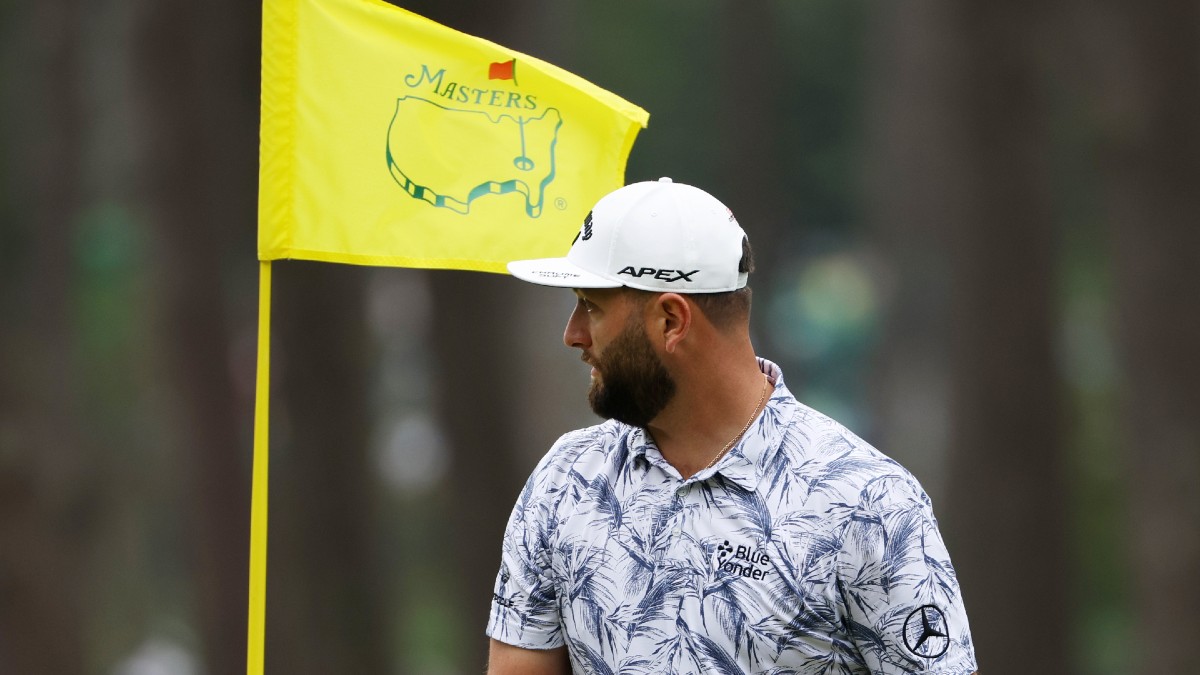
6. Be a Hater (or Boring)
A few years ago, I recommended using LIV golfers because 1) many golf fans turned on them, and 2) they had all been in pretty poor form entering the Masters or hadn't played much. They had three of the top 6 finishers that year.
I also always recommend using golfers that people dislike, because you may get some small ownership advantages from that dislike alone, despite their ability being the same as a comparable player — Patrick Cantlay is the poster-child for this, but Tom Kim, Brian Harman (both slow play), Patrick Reed and Sergio Garcia may also fall into this camp.
I think we could see a pretty big interest in a few LIV players, depending on how the tiers are set up, including Jon Rahm and Bryson DeChambeau.
LIV players I think will garner interest:
- Jon Rahm
- Bryson DeChambeau
- Joaquin Niemann
- Sergio Garcia
- Phil Mickelson
LIV players I think will be ignored:
- Dustin Johnson
- Patrick Reed
- Tyrrell Hatton
7. Know Your Scoring & Pool Size
I may tweak my strategy based on how the scoring works. These are usually the three types:
Score to par: In a pool where all your players' scores are added up, I'm looking for players who offer some floor. You're still going to need the winner to win a big pool that scores like this, but you can't have missed cuts and you need the bottom half of your lineup to finish strong and post some Top 30s.
Total prize money: You really need upside in this scoring format, because the winner is paid something like 15x more than 20th place. I'm more willing to gamble on players with win equity but with a slightly lower floor (Viktor Hovland, Patrick Reed and Cam Smith become more interesting in this format, where Tommy Fleetwood, Corey Conners and Denny McCarthy are a little less interesting).
Finishing position/picking the winner: Other pools score by finishing position, which is similar to score to par, but with less variance.
Knowing pool size: There's not an exact science to this, but the bigger the pool, the more contrarian you need to get. Even if you took Florida in a 20-person NCAA Tournament pool, you probably didn't win.
Again, this doesn't mean you should take the worst player in ever tier. But you need to be extra considerate of how popular your players are if you're in a big pool. Make a few key pivots to players you think almost no one will use (like 1, and you can actually have a shot to win if those guys hit.
8. Multi-Lineup Strategy
In a big pool, you may want to enter multiple lineups. How should you split them up?
I prefer an approach that mixes a few core players, and then different pivots further down your lineup. Some people refer to it as the cascading method in DFS. If you have five completely different lineups, it's going to be hard to get one right enough. You're just kind of spraying and praying.
However, if you nail 2-3 core plays and mix up the rest of your lineups, it's likely you'll get at least one lineup into serious contention since it's likely one lineup has some exposure to high-performers since you diversified so much.
Here's an example of what five lineups might look like:
9. Tier-by-Tier Breakdown
Alright, let's dive into the actual tiers on EasyOfficePools. Again, your pool may be slightly different, so use the general concepts — avoid what you believe will be the most popular plays in favor of comparable players who are being ignored. Don't just choose the worst player in each tier.
Tier 1

Scheffler and Rory McIlroy should occupy a good chunk of the ownership, and they're the two rightful favorites, leaving Rahm slightly under-owned. It's hard to know what LIV finishes mean given the disparity in quality up and down their tournament fields, but Rahm has finished in the top 10 in 15 of his last 16 tournaments across LIV, the DP World Tour, and the Olympics. His game is in fine shape.
This is exactly what happened two years ago when Scheffler was the defending champ, and McIlroy came in with top-3 finishes in 2-of-3 prior starts. Everyone loaded up on Scheffler and McIlroy, leaving Rahm used by only 12% of entries in my pool.
Other considerations: Xander Schauffele missed a chunk of this season with an injury and his form hasn't been great since returning, but if you want to gamble on the upside, I think most people will avoid him. He won two majors last year and finished top 10 in the other two. So much for can't close.
Tier 2
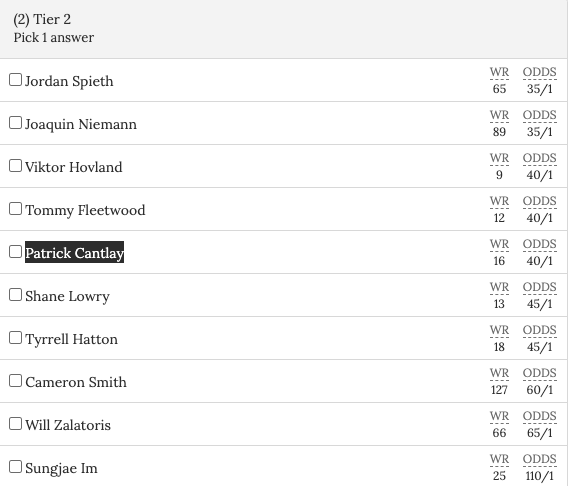
This tier will be much more diverse in usage, with some "Augusta Guys" like Jordan Spieth and Cam Smith, as well as some in-form players like Joaquin Niemann and Shane Lowry.
While Lowry is probably my favorite in this tier in a vacuum, I think he'll be popular, so I'll pivot to the perennially unpopular Patrick Cantlay. Will he win? Probably not. But his floor is super high, and as I discussed in the second section, I'm looking for floor over ceiling and hoping I get some breaks down the stretch.
Other considerations: Will Zalatoris is an Augusta Guy who isn't thought of like that — in three Masters he's gone 2, T6, T9. He was hurt for much of last year and is still rounding into form, with a strange 11 straight made cuts but zero top 10s in those starts. It's scary to count on a player to break through in a big way who hasn't been doing it leading up to the Masters, but he won't be very popular, and has the upside. If you want to go super contrarian, consider Zalatoris.
Tier 3
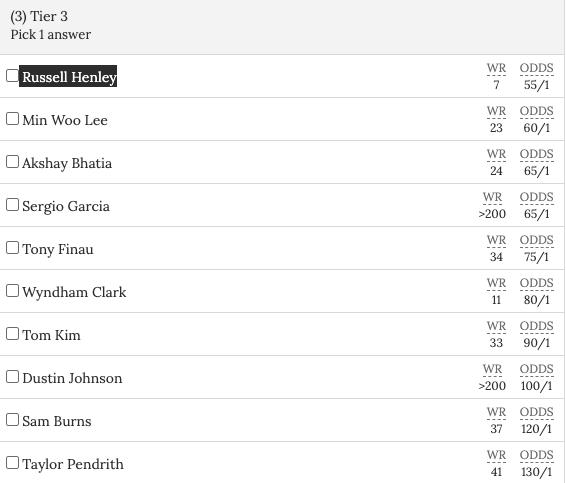
The top four players in this tier are all interesting and in-form, and many of the bottom six are wildly out of form, and I don't think anyone will want to use them.
Because I opted for less popular plays in the first two tiers, I went with the boring-but-reliable Russell Henley, who will be popular in this tier but probably not suck up all the ownership. I think Min Woo Lee will end up being the most popular play after his win in Houston, and his perceived course fit at Augusta.
Henley is DataGolf's highest-rated player in this tier by a good margin (No. 6 in the world) and while I don't think he can win the tournament, the floor is there. He was fourth at Augusta two years ago.
Other considerations: Sergio Garcia has been in great form on LIV though he's missed almost every cut at the Masters since he won in 2017. I don't know how popular he'll be — I think a lot of people have forgotten about him, but he'll be recommended as a popular sleeper in content this week.
Taylor Pendrith is also interesting, as I don't think he'll be very popular but is one of the longest hitters and best Par 5 players in the field, a critical skill at Augusta.
Tier 4
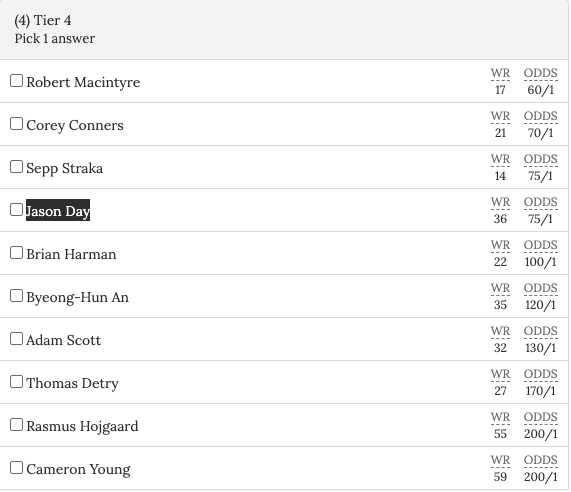
I love MacIntyre and Straka this week and have bet them in a few different markets, but I'm not the only one who feels that way, and I think the top three players will suck up a lot of the ownership. So I'll make a small pivot to Jason Day, who has been playing well, and his comparable odds to win to those two.
It's possible the name recognition of Day makes him slightly more popular in pools with more casual golf fans, but those same golf fans will see Straka and Bobby Mac on every "sleeper" list this week, so they'll be popular.
Other considerations: If I go super contrarian in Tier 1 with Schauffele or Justin Thomas, I'd consider using Straka or MacIntyre, both of whom I love and want to find ways to back this week.
Tier 5
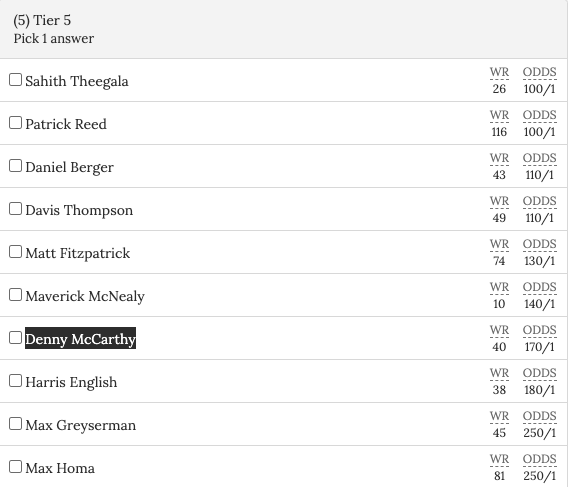
It doesn't feel like there's a ton of win upside in this tier, besides maybe Patrick Reed, which might make him a bit more popular. If you grouped all the LIV players together, Reed would likely be ignored, but up against some names that might be perceived as uninspiring, Reed kind of stands out.
But I'll go with floor again and take Denny McCarthy. He was T45 in his Masters debut last year but his short game should play well here, and he's a made cut and top 20 machine as probably the world's best putter.
Other considerations: I will use Reed in some lineups, banking on his upside.
Tier 6
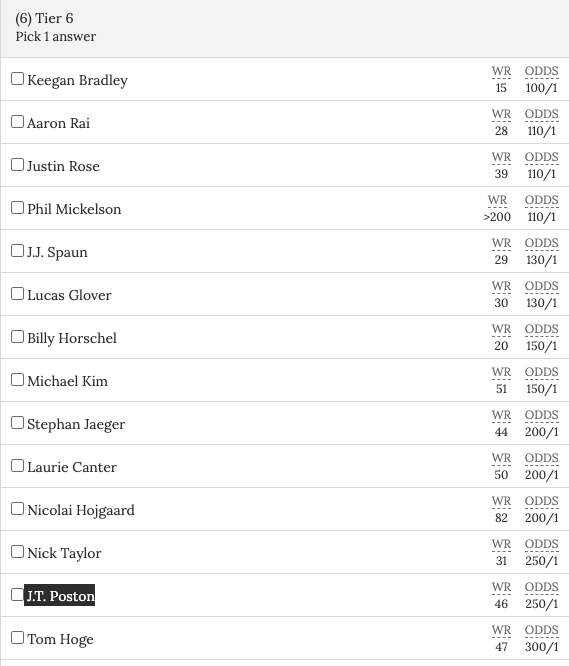
There are so many options in the big, final tier. A lot of people will just look at the odds or pick someone they know, so I'd expect Keegan Bradley, Aaron Rai and Phil Mickelson to be popular.
I'll go with J.T. Poston, another floor play who has gone MC, T30, T34 in three Masters appearances. He has no huge weaknesses in his game and shouldn't be a popular player. He won't sniff a win, but I don't need him to.
Other considerations:
- Kevin Yu: A great ballstriker who can't putt who nobody knows. A recipe for a super contrarian play who could fall into a top 20 finish if he gets a little bit out of the putter this week.
- Charl Schwartzel: He may be recommended on some sleeper lists so maybe I'm underestimating how popular he'll be, but he's trending up with a second-place finish at LIV Miami last week and his putter and short game have generally made him a good for for the Masters.
- Davis Riley: A true contrarian, upside-only play, Riley reached the top 50 in DataGolf's rankings in 2022 before falling outside the top 500 earlier this year. Now he's playing better again, with a T6 and T7 in his last four starts. Nothing encapsulates Riley's career better than his 2024 season, where he made 26 starts and finished inside the top 20 just twice — but one of those was a win at the Charles Schwab Challenge, besting Scheffler, Collin Morikawa and Keegan Bradley, who finished in spots 2-4 that weekend. If you want to gamble on someone no one else is going to use who could pull a T12 out of the clouds, Riley might be your guy.
Final Picks
If I could only make one entry, I'd go:
- Tier 1: Jon Rahm
- Tier 2: Patrick Cantlay
- Tier 3: Russell Henley
- Tier 4: Jason Day
- Tier 5: Denny McCarthy
- Tier 6: JT Poston
That's it! That's all I've got for you.
Again, try to poke around, get a sense of who everyone is talking about and avoid those guys. Use betting market data, but don't trust it blindly because everyone will do that.
And most importantly, don't be afraid to finish last. You will more often than you win, but when you win, you'll actually win money.


